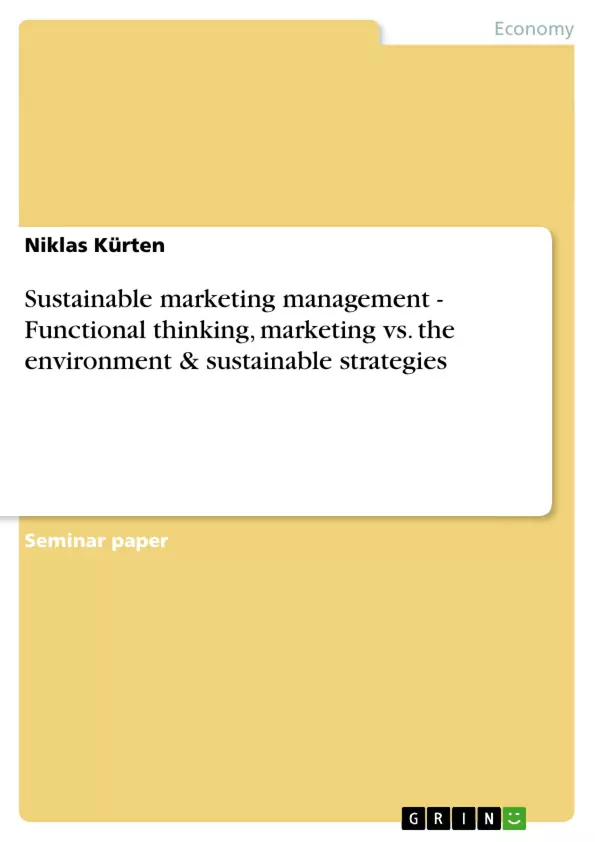The aim of this essay is to describe and to discuss the implications of a functional orientation on product development and market communication. Therefore firstly, the definition as well as the reasons of the need of the implementation of functional orientation are shown. Secondly, the consequences and dangers of this approach on product development and market communication are presented and discussed.
Further, the goal of the second part is to work out and describe the concepts of dematerialisation as well as functional orientation from a sustainable perspective. Therefore, the term ‘dematerialisation’ is definded and a brief general overview about the current situation is given. Secondly, this approach as well as the approach of functional orientation will be presented and discussed out of a sustainable perspective.
Finally, the aim of the last elaboration is to work out the paradoxes between the theoretical approach of marketing, namely the foundations of marketing, and the concepts and values of a sustainable society. It will be conducted, what problems might appear when these two approaches are brought together. Therefore, first of all the theoretical foundations of marketing are named and described. Secondly, the concepts and values of a sustainable society are shown and discussed. After this, the problems which are occuring, when these two approaches are brought together, are presented.
Inhaltsverzeichnis (Table of Contents)
- I. Functional Thinking
- a) Describe and discuss the implications of a functional orientation on product development and market communication.
- b) Discuss the concepts of dematerialisation and functional orientation from a sustainable perspective.
- II. Marketing vs. the environment
- a) Describe and discuss the main paradoxes between the theoretical foundations of marketing and the concepts of a sustainable society.
- b) In the research area of environmentally friendly consumer behaviour, the commercialisation of eco-friendly products and services is often described as a communication problem.
- III. Sustainable Strategies
- a) Describe and analyse differences among strategies focusing on sustainability/environmental issues.
- b) The use of environmental management systems (EMS) reflects different strategic positions.
Zielsetzung und Themenschwerpunkte (Objectives and Key Themes)
This essay explores the implications of functional orientation on product development and market communication, examining its potential benefits and drawbacks within a sustainable context. It further analyzes the relationship between marketing and environmental concerns, exploring the inherent paradoxes between the two. The essay then delves into different sustainability strategies, including the use of environmental management systems, highlighting their potential impact on businesses.
- Functional Orientation in Product Development and Market Communication
- Sustainable Marketing and Environmental Concerns
- Dematerialisation and Functional Orientation from a Sustainable Perspective
- Strategies for Sustainable Business Practices
- Environmental Management Systems and their Impact on Business
Zusammenfassung der Kapitel (Chapter Summaries)
I. Functional Thinking
This chapter examines the implications of a functional orientation on product development and market communication. It defines functional orientation and explores its impact on different business units within a company, highlighting the potential for increased innovation or customer focus. The chapter also discusses the dangers of an overly focused approach, using the example of Nike and its outsourcing practices.
II. Marketing vs. the environment
This chapter focuses on the inherent contradictions between marketing principles and the need for a sustainable society. It explores the potential conflicts that can arise when attempting to integrate these two perspectives. The chapter also discusses the communication challenges involved in promoting environmentally friendly products and services, drawing on research within the field of environmentally friendly consumer behavior.
III. Sustainable Strategies
This chapter analyzes different strategies for incorporating sustainability into business practices. It explores the various approaches to addressing environmental concerns and examines the use of environmental management systems (EMS) as a strategic tool. The chapter discusses the different positions reflected in the use of EMS and their potential impact on business strategy.
Schlüsselwörter (Keywords)
This essay explores key concepts within sustainable marketing management, focusing on functional orientation, dematerialisation, environmental issues, sustainable strategies, environmental management systems (EMS), marketing vs. the environment, and environmentally friendly consumer behavior.
- Citar trabajo
- Niklas Kürten (Autor), 2006, Sustainable marketing management - Functional thinking, marketing vs. the environment & sustainable strategies, Múnich, GRIN Verlag, https://www.grin.com/document/79074



